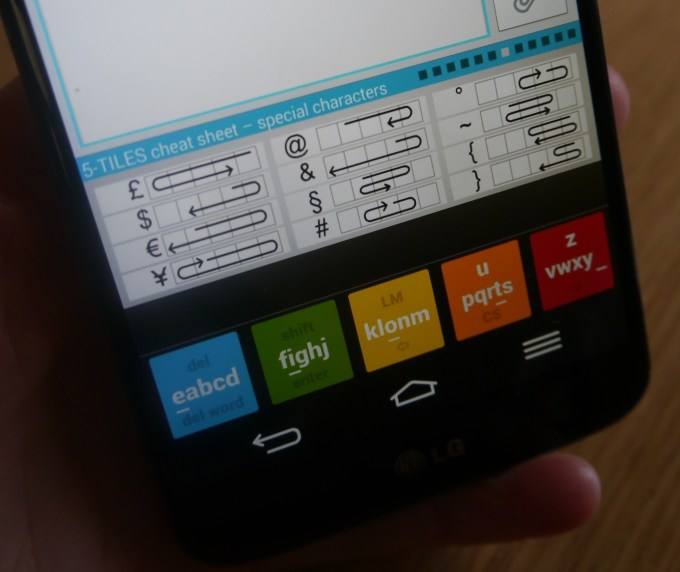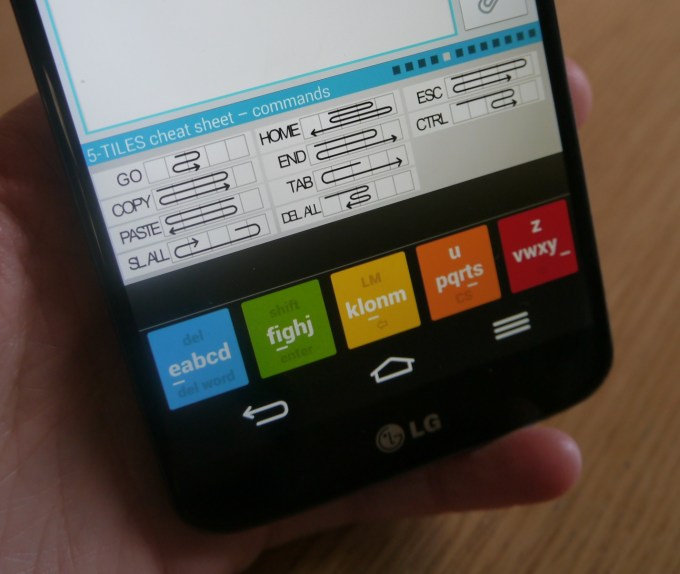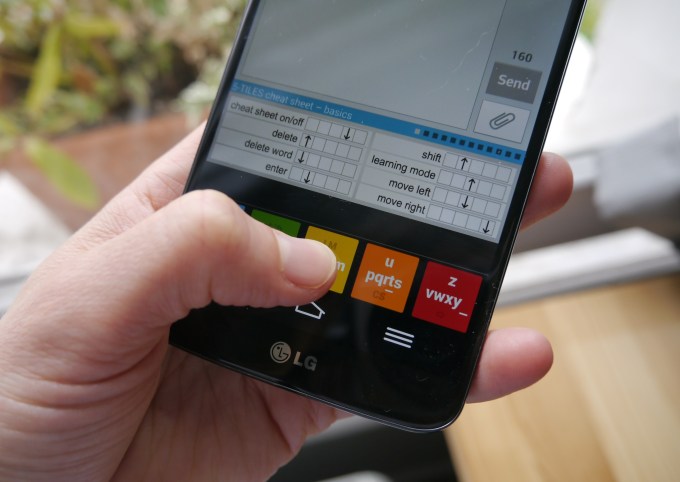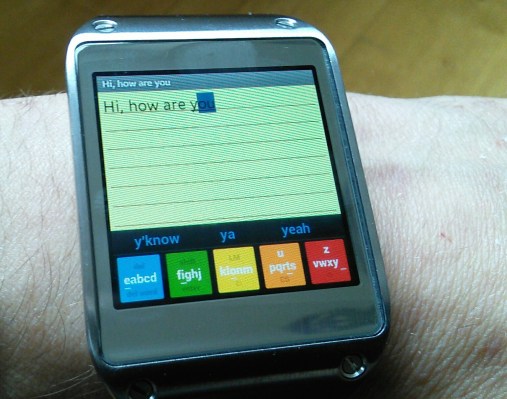Meet the 5-Tiles Keyboard, (yet) another contender taking aim at disrupting Qwerty — and hoping to increase its chances by first targeting smaller wearable devices, such as smartwatches. The rational being that’s a more realistic way to drive a wedge between Qwerty and its users’ fingers.
As challenges go, disrupting Qwerty is akin to attempting to pass Yahweh’s tests in the Grail temple at the end of Indiana Jones & The Last Crusade. The alternative keyboard playing field is littered with the carcasses of those that haven’t made it.
Yet still startups continue to fling themselves at this impossible chasm. (Ok, it might not be literally impossible but it’s going to require a near miracle to shift ingrained Qwerty habits in the short term).
So many attempts to reinvent the keyboard have failed — or are grinding away without really going anywhere — with good reason. They are trying to overthrow what’s approaching 150 years of muscle memory. Qwerty is, after all, just a quirk of the mechanical design of typewriters from the 1870s, as we’ve noted previously.
But that quirk (and its regional variants) is now embedded in the minds of countless tech users — with more being indoctrinated into its tip-tappety ways every day on their smartphones and tablets and laptops and so on.
Still the monumental scale of the challenge hasn’t stopped startups trying. Because Qwerty is undoubtedly imperfect. It was optimized for little metal arms to fly speedily, not for fleshy fingers. And it takes up a whole chunk of screen real estate for no good reason.
The rise of the touchscreen does also open up the possibility to disrupt Qwerty. Much harder to reconfigure people’s plastic keyboards than to get them to try a new bit of software (well, on the Android platform at least; Apple’s iOS remains firmly in the Qwerty Preservation Society camp).
And, of course, the startup that does, finally surpass Qwerty with a better alternative that gets enough traction to become a new standard is undoubtedly going to become as immortal as Indiana Jones and his dad after they supped from the bona fide Holy cup.
Five tiles for wearables
And so we come to the 5-Tiles Keyboard: an alternative touchscreen typing interface for Android devices that ditches Qwerty in favour of a roughly alphabetic layout. That’s not the big difference here though.
The startup’s key (ha!) innovation is to reduce the number of keys displayed on the keyboard to five (hence the name), and to switch the letter selection mechanism to a mixture of taps and gestures.
Using gestures allows for individual letter selection to take place, without having to display 26 different keys on the screen. So it can save a lot of screen real estate — something that’s especially pressing on the relatively small screens of smartwatches or indeed other wearables. It reckons its interface could even work on Google Glass.
The use of gestures for inputting characters allows 5-Tiles to incorporate numbers and special characters onto the same keyboard as the alphabet — provided, of course, you can memorise all the hieroglyphs required to squiggle out the different characters.

5-Tiles says its main advantage — aside from taking up less space — is that it can fit a lot of input permutations into that small strip. So it’s small but potent.
It’s not, however, the only alternative keyboard taking aim the smartwatch. Canada’s Minuum has also been flagging up this angle for its alternative keyboard which squishes the entire Qwerty layout into a fraction of the screen space, and uses an auto-correct algorithm to push word suggests at the user, and gesture controls to cycle through suggestions.
Minuum is attempting to make Qwerty work for it. 5-Tiles, on the other hand, presents its users with a much steeper learning challenge since they not only have to learn gestures to input things like numerals but also have to rethink the entire process of how they type.
If you set aside the learning curve challenge, 5-Tiles is undoubtedly offering an elegant solution to the problem of small screens plus Qwerty keyboards — even supporting handy functions like copy and paste within its spectrum of gestures.
But convincing people to make the leap of faith to a new way to type remains a formidable obstacle.

Hands on with 5-Tiles
So how exactly does the 5-Tiles Keyboard work? The letters of the English alphabet are divided into groups of five which are displayed on each tile (it’s four letters plus space for the last tile).
On each tile, the letter that’s most used is underlined. This means you just tap the tile to type that letter. For all other letters a swipe is required. Either a swipe to the right or the left, depending on the letter in question and its relative placement to the underlined letter.
So, for instance, the first tile on the keyboard can either be tapped on, to type the letter ‘e’, or becomes the start point of a swipe right which can extend one tile to the right, to type the letter ‘a’, or all the way to the fifth tile in the row, to type the letter ‘d’.
Most of the tiles also holds shortcut functions for an up swipe or a down swipe — so, for instance, swiping down on the first tile will delete a word, while swiping up will delete a letter. Shift, enter, left and right cursor keys and even a shortcut to a 5-Tiles cheatsheet (which details all the gestures the system supports) are housed as up or down swipes elsewhere.
But, once again, the presence of that cheatsheet points to the thorny learning issue. Learning 5-Tiles is not the work of five seconds, five minutes, or even five hours. It’s going to take a heck of a lot longer than that to forget your Qwerty muscle memory and get fast enough for 5-Tiles’ gesture based typing interface to start feeling useful, not annoying. Certainly if you’re trying to use it on a smartphone, anyway.
TechCrunch witnessed the startup’s co-founder and CEO Michal Kubacki, who came up with the original concept for 5-Tiles way back in 2004 (see below for the full backstory), using the keyboard on his Samsung Galaxy handset and can attest to the fact that he was indeed very quick. But he’s been beavering away on this project for well over five years.
The same could not be said of TechCrunch’s attempts to use 5-Tiles. Painstaking was a more accurate description. Every letter you type has to be individually sought out, and additional gestures — such as a hyphen — can require substantial and rather fiddly paths to be traced over the tiles. Our fingers were certainly not flying o’er the keys.

However, it is undoubtedly true that the speed issue is likely to be less of an irritant on a smartwatch — where the user is unlikely to be typing an epistle anyway. Text input needs on smartwatches are going to be bite-sized, so the learning barrier for 5-Tiles may well be less of a pain point there than elsewhere.
An analogy could be the old school nine-key keypads of first gen mobile devices which spread the alphabet over those keys and required users to multi tap each button to get to the letter they needed. Mobile users managed to learn to type that way, despite how fiddly it was. Needs must, and all that.
So now this startup just needs the smartwatch/wearables category to seriously uplift to drive demand for its alternative keyboard interface. Which is of course another challenge it’s business is facing. If your business is tied to the success of a wearable such as Google Glass you may be hanging around twiddling your thumbs in the short-term.
Backstory
The backstory to 5-Tiles is typical of an entrepreneur first and foremost wanting to scratch their own itch, but will also resonate with anybody armed with an idea who doesn’t have the technical skills to bring it to fruition. The brainchild of co-founder and CEO Michal Kubacki, who has a background in creative writing — spanning scriptwriting, poetry, song lyrics, and authoring short science fiction stories in his native Poland, 5-Tiles inception goes back as far as 2004.
Kubacki remained convinced the mobile phone was ‘potentially the best writing tool ever created.’
“I was spending all day in excavations (being at the bottom of an unsecured 5 meter hole does miracles to your creative thinking, but you can’t recall much when you’re out of it) or trying to write something in the back of the truck. I started to use the mobile phone to write down some things and I’m still not sure what was harder, cutting through the rock all day to lay a water pipe in it, or trying to write about it on my Nokia N70.”
But, despite these frustrations, Kubacki remained convinced the mobile phone was “potentially the best writing tool ever created”, and when rumours of the iPhone began to surface, with its “fantastic, new, never-seen-before keyboard”, he was hopeful Steve Jobs had solved his problem.
“I’m a trained typist, I love to touch type on the computer and I wanted to have exactly the same experience while writing on a mobile phone — the feeling that your thoughts somehow appear on the screen without you focusing on the process. Anyone who touch-types knows what I’m talking about,” he says.
Instead, the solution Jobs unveiled on January 9th 2007 — a nicely designed on-screen Qwerty with a sprinkling of autocorrection — left Kubacki wanting. “I can’t tell you how disappointed I was,” he says. “I started to think about a better solution. I knew it had to be compact, but the keys should be bigger than on a Qwerty. The only way to do it was to reduce the number of the keys.”
There was only one problem: Kubacki didn’t know how to code, nor did he know anyone else who could develop his idea for him. Undeterred, however, he set about teaching himself ActionScript, the scripting language behind Adobe Flash — good enough to build an early prototype running on a desktop computer.
“It was far from being usable, but what I found encouraging was the speed at which I could learn the combinations. I was expecting that a few weeks would be needed to memorise the alphabet, based on my experience of learning to type on Qwerty. But it appeared that with only 5 keys I could memorise all the combinations in less than 30 minutes,” he recalls.
The next logical step was to build a version of the 5-Tiles keyboard running on a mobile phone, but Kubacki was clueless how to go about it and was forced to put the project on hold for another 3 years.
I had this crazy idea that everyone in the City understands how to deal with these kinds of projects and has Steve Jobs’ number on their phone Michal Kubacki
Kubacki then did what many a fledgling entrepreneur does when they think they are on to something, he began telling anybody and everybody who would listen about his invention. “I had this crazy idea that everyone in the City understands how to deal with these kinds of projects and has Steve Jobs’ number on their phone, so I was pitching my idea to everyone while making lattes,” he says.
Following advice from a customer, who told him he should probably patent the idea before talking about it too much, Kubacki did just that, before relentlessly pitching again. This led to co-worker Fabio Carta (now 5-Tiles CTO) asking to borrow his phone so that he could try building a proper version for Android.
“Two days later he brought my phone back and there it was!” says Kubacki. “The first version could only write in capital letters, with no numbers or punctuation, but boy it was fast! In few minutes I was typing faster than on stock Android Qwerty and I knew we were onto something big.”
Additional functionality was added, such as a full set of numbers, symbols, and Polish and Italian characters, before publishing a version to the Google Market app store. “[We] were making preparations for not going back to work after the weekend, figuring we’ll be rich by then,” says Kubacki.
A few weeks and a mere seven downloads later, they realised it wasn’t that simple. Rather than making money, what they did get, however, was potentially more valuable: feedback from actual users, and lots of it. This led to Kubacki ditching the keyboard’s “exotic layout”, based on the famous ETAOIN SHRDLU phrase, and quitting his day job at the cafe to work on the project full time. He then began networking like crazy, including attending Science Hack Day for Citizen Cyberlab where he teamed up with organiser Margaret Gold who is now helping to steer the business side of 5-Tiles.
Since those early versions, the product has changed dramatically, says Kubacki, and now boasts an improved keyboard layout, based more closely on the alphabet, and multiple dictionaries and word prediction. Work that hasn’t gone unnoticed. The startup won second place at the 2013 Droidcon Demo Camp, where Kubacki met smartwatch maker “I’m” and verified the usability of the 5-Tiles keyboard on smartwatches.
The startup was also a finalist in the SMART UK competition and has won two UKTI sponsored competitions, providing exhibition space at MWC in Barcelona and CeBIT in Hannover. 5-Tiles also won first place at TechPitch 4.5, a regular pitching event held near London’s Tech City, which is where TechCrunch first learned of the company.
